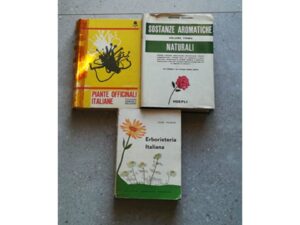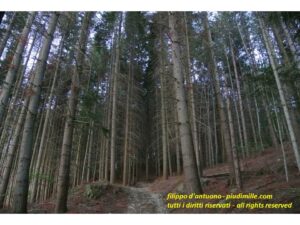Forest bathing, therapy or self-care ?
(Thoughts about research, terpenes, colds, childhood memories and short memory)
October 18, 2021
Forest bathing, or forest therapy, depending on perspectives, is definitely a fashionable topic. Not that it is new but, having become a fashion, experts abound. And also research entered the arena.
Last week I attended at the Montagnaterapia (Mountain therapy) congress. It was very interesting, especially for the enthusiasm and motivation of many operators. Some contributions, among which also one from me, also dealt with Forest bathing or forest therapy. Some contributions also spoke of terpenes, some of the volatile compounds produced by plants. Before going on, I recall some childhood memories, that suddenly came to my mind, hearing some kind of approaches.
In the images you see three “historical” medicines.
The line “Vicks”: from their web site you can read that it was invented in the US at the end of the 19th century. When I was a boy, the stick called “Vicks inalante” was a sort of toy, to be inserted into the nose and inhaled, during cold episodes. I had one in my pocket almost all the time. A second item, Vick Vapurub was less appealing for me, since it was a somewhat greasy liniment, to be applied on chest or back. The name is self-explaining: a volatile component (vapo-), that develops by rubbing (rub). The active substances of these remedies are terpenes, in this case menthol, eucalyptol, camphor, turpentine, among the more widely widespread and studied terpenes. Data about the absorption and elimination dynamics of these compounds do also exist, and are available (an example here). So, nothing really new, their effect is known, since long time.
This effect of relief on the respiratory system is called “balsamic”. Yes, “balsamic”: maybe a somewhat obsolete word, but at the same time, a widely used term in the traditional texts of herbal medicine (in the picture see three examples from my library, dating from the sixties-seventies of the past century).

The classical Vicks Vaporub jar, almost the same since ever

Three old books about herbal medicine and natural plant substances, from my library
Then it also came to my mind another product, called “Recto mugòlio”. The name was peculiar for me, when I was a boy, since I did not understand it well but, at the same time, it was terrifying, knowing that is was about suppositories. Indeed, also in this case, the name is self-explaining “recto”, referred to the place through which the product was administered and “mugòlio”, so oil of mountain pine. The name, however, also amused me, since I pronounced “mugolìo”, so with the “ì” stressed. In Italian, mugolìo is a kind of whiny sound: so you can imagine what a “mugolìo” coming from the bottom could evocate to me. Nowadays this product seems to be out of commerce, because a lack of interest of the producers, not applying again to renovate the authorisation as an approved remedy.

A vintage Recto mugòlio advertising poster
Finally, a note on the Valda drops, another historical remedy, which origin dates back to 1905, cannot be missing. Also these drops have a balsamic effect, due to menthol and eucalyptol. Their metal box was a kind of myth. Especially in winter time, it happened to have always one inside my pocket.

The inviting aspect of the Valda dorps

The classical metal box of the Valda drops
Following my thoughts, I also reminded my travels to eastern Europe, during which I realised that the use of natural remedies was still very valuated there; pine cones and gems were among the ones still widely in use, for their balsamic effect.
Well, after this disquisition, let’s come back. I heard of research about terpenes like a highly innovative topic, “opening a world”. And this could definitely be a matter of debate.

Pine sladko: a sugar sirup with pine cones, with balsamic action, Rodopi mountains, Bulgaria

Pine cones on sale, road market, Crimean peninsula

Pine cone preserves, Crimean peninsula
Forest bathing and terpenes
Terpenes are compounds of plant origin, often strongly odorous, and therefore at least indirectly known my most of us: they in fact represent the scents of most condiment plants, like sage, rosemary, basil, oregano, parsley, anise, but also of many vegetables, like carrot, celery, fennel, of citrus peels, conifer resins, perfume plants, like lavender, jasmine and many others. Chemically, terpenes are known since well over a century ago; simply, their knowledge improved together with the progress in general knowledge of chemistry and the availability of new analytical methods and instrumentation.
About 30 years ago, a wave of enthusiasm raised, for the open field research on substances indicated as VOCS (volatile organic compounds). So, organic substances that easily vapourise, generated by living organisms, among which plants. Terpenes represent an important part of the plant originated Vocs, even since they are easily perceived by our senses. At these times, the interest was mainly on the plant physiological and ecological role of terpenes, so their metabolic functions in plants and their role for communication between plants and other beings.
Presently, there is a new wave of interest for these compounds, released in the environment, as potential healing factors. Their name has been changed into BVOCS, where B stands for biogenetic, to acknowledge the fact that many, especially non-biogenetic, VOCS are also powerful poisons. We have seen how the balsamic effect of terpenes is known since long time, so, no wonder about their beneficial effect on the respiratory functions. Ok, also different effects are being studied; but also these were already partly known, like the ones on mood, sleeping etc.
So, research is of course OK. But, to be really useful, and make some step forward, it must be solidly based on previous knowledge. And, it must also be considered that the determination, in the open environment, of quantitative relations between terpenes and some human physiological indicators, and even more, general physical or mental health status, could be a hard goal to reach. Nor results from controlled environment experiments could be completely extrapolated. In fact, there as so many interfering factors, in the open environment, that the “background noise”, so the uncontrolled variables, may become a preponderant part of what is usually referred to as the “experimental error”. In this situation, reliable estimates would require such an high amount of data that… we could be almost sure that also the present wave of research interest will end well before this goal could be achieved.
Forest bathing and therapy
Coming back to forest bathing. The perception of its positive effects is high. We also can well perceive the scents of nature, among which, terpenes: who cannot be pleased of the scent of a conifer forest ? But, staying in nature has a far higher value, likely not quantifiable by scientific methods. So, the use of a single factors, including terpenes, to attract the attention, or the hope on some benefits, may be reductive, and lead to disappointment, and to an opposite effect compared to what expected, so to a loss of interest.
So, let’s try not to under-evaluate approaches that may look as being non-scientific . Forest bathing is valuable for all it can offer, going beyond terpenes, and not being the same for everyone. That is the reason why the guide is, after all, a mediator, who should allow everybody to extract what is individually more important, from a forest bathing experience.
filippo d’antuono – piudimille.com
all rights reserved

